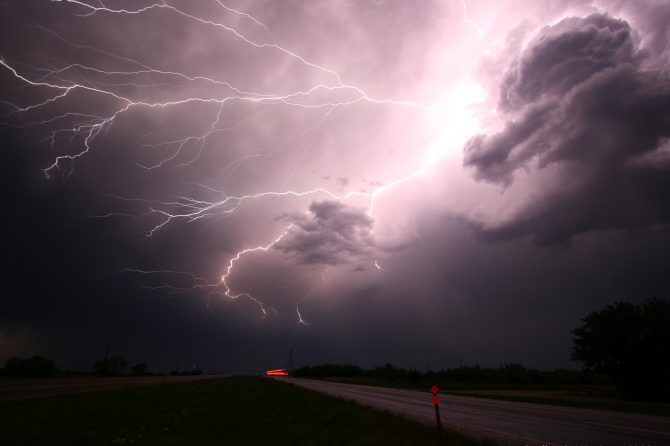
AKTUELNO❗
THUNDER STRIKE
As one of the most fascinating natural phenomena, lightning has fascinated and frightened man for most of human history.
A thunderstorm (fulguratio) is caused by the occasional, sudden and strong discharge of electrical voltage between a cloud and the ground. The resulting light phenomenon is called a flash, and the sound phenomenon is called thunder.
More people die from lightning strikes than are killed by tornadoes or other natural disasters, including earthquakes, floods, volcanoes, etc.
A lightning strike is actually a massive DC (direct current) shock, ie a direct current shock of enormous energy. The voltage can be several hundred million V, up to 200,000 amps. Despite such high energy, lightning strikes are less lethal than high-voltage "technical current" strikes, and the damage caused shows significant differences.
The difference is determined by the following facts:
- lightning is direct current and thus less harmful than technical alternating current, whose dangerous frequency is closely related to electric shock accidents
- the time of lightning contact with the body is instantaneous, extremely short (1-100 milliseconds), while in the case of an electric shock the contact is often prolonged due to tetanic contraction of the musculature, which is one of the main causes of severe tissue and organ damage.
- in most cases the lightning energy passes only through the surface of the body. (It is known that current travels only through the surface of metal conductors, we can simply understand that current passes through the surface of the body as in other conductors).
The death toll is especially high in the open as more and more people are trying to find salvation from everyday obligations and crowds in various resorts in nature.
Lightning strikes can be direct or indirect. People who are outdoors during a storm, especially if they are carrying metal objects, can experience a direct lightning strike and then more than 60% of people immediately lose their lives. However, it is most often suffered by hiding under trees or some other object. Such an indirect lightning strike occurs when a direct current passes, for example, through a tree, which has a higher resistance than the air between the tree and the victim. The current then finds a path of less resistance and passes through the victim into the ground. Lightning strikes the ground as well; if a man stands in close proximity, the difference in potential between the separated feet may be large enough for current to enter the ground through the feet. (The term "step voltage" is known in electrical engineering). In this way, whole groups of people can be killed, often on sports fields, public events, then herds of animals, etc.
The number of casualties indoors is lower due to the existence of lightning protection.
Possible consequences of lightning strikes
Survivors of lightning strike show mostly transient, neurological, cardiovascular and other disorders (loss of consciousness, amnesia, paresis, tachycardia, chest pain, dizziness, etc.).
A victim of a lightning strike can often find a strong rift between clothing and footwear near the intact body, or burns where sweat or raindrops suddenly turn to steam, or burns under heated or melted metal objects that have found their way into the current (metal buttons). , bracelets, etc.) This can be explained by the phenomenon of lightning passing only by the surface of the body. That is the reason why as many as 70-80% of people who are struck by lightning survive an accident.
During a lightning strike, blast injuries can also occur (injuries that occur due to the transfer of high pressure from the center of the explosion by air, water or solid matter). Lightning can heat the air to 8,000o C in a split second. There is an explosive expansion of ionized and heated air, and soon the sudden cooling causes a secondary effect of implosion, with all the consequences of air blast on the body (rupture of the eardrum in 50% of cases of lightning, bone fractures , closed and open chest injuries, etc.).
Burns of various shapes can be seen on the skin. A fern-like burn on the skin indicates a lightning strike, but both linear and punctiform (spotted) shapes can be seen due to the evaporation of the droplets. Sometimes burns can be noticed only after several hours from the moment of onset. In the most severe cases, certain parts of the body, mainly the extremities, are carbonized.
People with spontaneous heart and respiratory problems, especially those who are mobile, generally survive lightning strikes.
Assistance procedures:
Cardiopulmonary resuscitation:
Massive DC shock simultaneously and completely depolarizes the entire myocardium and primarily asystole (cardiac arrest) occurs. Ventricular fibrillation (cardiac ventricular fibrillation) occurs mainly secondary to hypoxia caused primarily by respiratory arrest.
The resuscitation procedure consists of heart massage and artificial respiration. Timely application of resuscitation measures enables rescue in most cases of respiratory and cardiac arrest, ie respiratory arrest and heart failure.
Thermal and mechanical injury care:
Attention should be paid to injuries to the head and other parts of the body, which can be caused by the direct action of lightning strikes, or secondarily due to the rejection and action of the air blast.
Symptomatic therapy:
-Monitoring of vital functions (heart and respiratory function) is required.
- Therapy of heart rhythm disorders
- Convulsions (cramps, twitching) are treated with standard anticonvulsants
Safeguard measures
When a person is outside areas that have a technically well-executed lightning protection installation, it is difficult to recommend and prescribe reliable lightning protection measures. The general recommendation is to take any shelter, and for this activity remains between 5 and 10 minutes after
which is the first time a slight thunder is heard.
The best shelter in such a situation is a car, a railway car or an abandoned house. In many cases, we do not have the ability to seek safety indoors. It is then recommended that the individual "reduce" his height, ie to squat and shrink, so as not to become a place of lightning strikes. It is also good to find shelter in some ditch. Going under a tree is debatable, especially under one that is lonely.
Indirectly, a person can be struck by lightning if he is near buildings that have a poorly executed or no lightning installation at all. If it is located inside a building that has no lightning installation at all, it should stand in the middle of the room, away from the walls.
mr.sc. Adem Zalihić, MD




